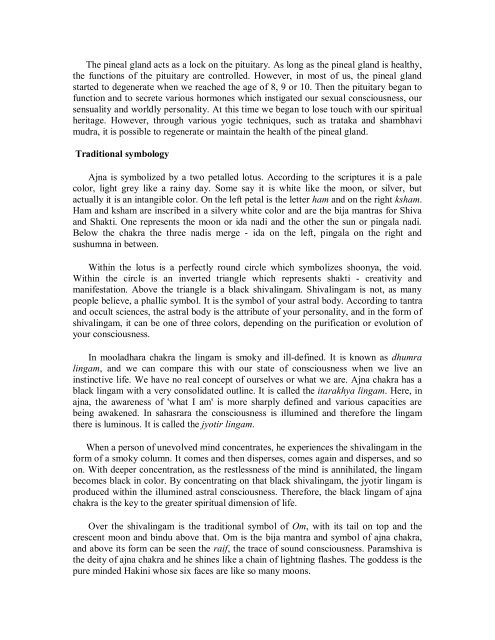Kundalini.Tantra.by.Satyananda.Saraswati
Create successful ePaper yourself
Turn your PDF publications into a flip-book with our unique Google optimized e-Paper software.
The pineal gland acts as a lock on the pituitary. As long as the pineal gland is healthy,<br />
the functions of the pituitary are controlled. However, in most of us, the pineal gland<br />
started to degenerate when we reached the age of 8, 9 or 10. Then the pituitary began to<br />
function and to secrete various hormones which instigated our sexual consciousness, our<br />
sensuality and worldly personality. At this time we began to lose touch with our spiritual<br />
heritage. However, through various yogic techniques, such as trataka and shambhavi<br />
mudra, it is possible to regenerate or maintain the health of the pineal gland.<br />
Traditional symbology<br />
Ajna is symbolized <strong>by</strong> a two petalled lotus. According to the scriptures it is a pale<br />
color, light grey like a rainy day. Some say it is white like the moon, or silver, but<br />
actually it is an intangible color. On the left petal is the letter ham and on the right ksham.<br />
Ham and ksham are inscribed in a silvery white color and are the bija mantras for Shiva<br />
and Shakti. One represents the moon or ida nadi and the other the sun or pingala nadi.<br />
Below the chakra the three nadis merge - ida on the left, pingala on the right and<br />
sushumna in between.<br />
Within the lotus is a perfectly round circle which symbolizes shoonya, the void.<br />
Within the circle is an inverted triangle which represents shakti - creativity and<br />
manifestation. Above the triangle is a black shivalingam. Shivalingam is not, as many<br />
people believe, a phallic symbol. It is the symbol of your astral body. According to tantra<br />
and occult sciences, the astral body is the attribute of your personality, and in the form of<br />
shivalingam, it can be one of three colors, depending on the purification or evolution of<br />
your consciousness.<br />
In mooladhara chakra the lingam is smoky and ill-defined. It is known as dhumra<br />
lingam, and we can compare this with our state of consciousness when we live an<br />
instinctive life. We have no real concept of ourselves or what we are. Ajna chakra has a<br />
black lingam with a very consolidated outline. It is called the itarakhya lingam. Here, in<br />
ajna, the awareness of 'what I am' is more sharply defined and various capacities are<br />
being awakened. In sahasrara the consciousness is illumined and therefore the lingam<br />
there is luminous. It is called the jyotir lingam.<br />
When a person of unevolved mind concentrates, he experiences the shivalingam in the<br />
form of a smoky column. It comes and then disperses, comes again and disperses, and so<br />
on. With deeper concentration, as the restlessness of the mind is annihilated, the lingam<br />
becomes black in color. By concentrating on that black shivalingam, the jyotir lingam is<br />
produced within the illumined astral consciousness. Therefore, the black lingam of ajna<br />
chakra is the key to the greater spiritual dimension of life.<br />
Over the shivalingam is the traditional symbol of Оm, with its tail on top and the<br />
crescent moon and bindu above that. Om is the bija mantra and symbol of ajna chakra,<br />
and above its form can be seen the raif, the trace of sound consciousness. Paramshiva is<br />
the deity of ajna chakra and he shines like a chain of lightning flashes. The goddess is the<br />
pure minded Hakini whose six faces are like so many moons.














![[Lonely Planet] Sri Lanka](https://img.yumpu.com/59845622/1/169x260/lonely-planet-sri-lanka.jpg?quality=85)


